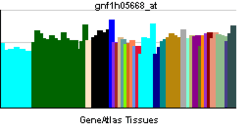SH3RF1
| SH3 domain containing ring finger 1 | |||||||||||||
|---|---|---|---|---|---|---|---|---|---|---|---|---|---|
| Identifiers | |||||||||||||
| Symbols | SH3RF1 ; POSH; RNF142; SH3MD2 | ||||||||||||
| External IDs | MGI: 1913066 HomoloGene: 10988 GeneCards: SH3RF1 Gene | ||||||||||||
| |||||||||||||
| RNA expression pattern | |||||||||||||
 | |||||||||||||
| More reference expression data | |||||||||||||
| Orthologs | |||||||||||||
| Species | Human | Mouse | |||||||||||
| Entrez | 57630 | 59009 | |||||||||||
| Ensembl | ENSG00000154447 | ENSMUSG00000031642 | |||||||||||
| UniProt | Q7Z6J0 | Q69ZI1 | |||||||||||
| RefSeq (mRNA) | NM_020870 | NM_021506 | |||||||||||
| RefSeq (protein) | NP_065921 | NP_067481 | |||||||||||
| Location (UCSC) | Chr 4: 170.02 – 170.19 Mb | Chr 8: 61.22 – 61.4 Mb | |||||||||||
| PubMed search | |||||||||||||
Putative E3 ubiquitin-protein ligase SH3RF1 is an enzyme that in humans is encoded by the SH3RF1 gene.[1][2]
Function
This gene encodes a protein containing an N-terminus RING-finger, four SH3 domains, and a region implicated in binding of the Rho GTPase Rac. Via the RING-finger, the encoded protein has been shown to function as a ubiquitin-protein ligase involved in protein sorting at the trans-Golgi network. The encoded protein may also act as a scaffold for the c-Jun N-terminal kinase signaling pathway, facilitating the formation of a functional signaling module.[2]
Interactions
SH3RF1 has been shown to interact with AKT2[3] and MAP3K11.[3]
References
- ↑ Tapon N, Nagata K, Lamarche N, Hall A (Apr 1998). "A new rac target POSH is an SH3-containing scaffold protein involved in the JNK and NF-kappaB signalling pathways". EMBO J. 17 (5): 1395–404. doi:10.1093/emboj/17.5.1395. PMC 1170487. PMID 9482736.
- ↑ 2.0 2.1 "Entrez Gene: SH3RF1 SH3 domain containing ring finger 1".
- ↑ 3.0 3.1 Figueroa C, Tarras S, Taylor J, Vojtek AB (Nov 2003). "Akt2 negatively regulates assembly of the POSH-MLK-JNK signaling complex". J. Biol. Chem. 278 (48): 47922–7. doi:10.1074/jbc.M307357200. PMID 14504284.
Further reading
- Lyons TR, Thorburn J, Ryan PW, Thorburn A, Anderson SM, Kassenbrock CK (2007). "Regulation of the Pro-apoptotic scaffolding protein POSH by Akt". J. Biol. Chem. 282 (30): 21987–97. doi:10.1074/jbc.+M704321200. PMID 17535800.
- Kimura K, Wakamatsu A, Suzuki Y, Ota T, Nishikawa T, Yamashita R et al. (2006). "Diversification of transcriptional modulation: large-scale identification and characterization of putative alternative promoters of human genes". Genome Res. 16 (1): 55–65. doi:10.1101/gr.4039406. PMC 1356129. PMID 16344560.
- Alroy I, Tuvia S, Greener T, Gordon D, Barr HM, Taglicht D et al. (2005). "The trans-Golgi network-associated human ubiquitin-protein ligase POSH is essential for HIV type 1 production". Proc. Natl. Acad. Sci. U.S.A. 102 (5): 1478–83. doi:10.1073/pnas.0408717102. PMC 545085. PMID 15659549.
- Figueroa C, Tarras S, Taylor J, Vojtek AB (2003). "Akt2 negatively regulates assembly of the POSH-MLK-JNK signaling complex". J. Biol. Chem. 278 (48): 47922–7. doi:10.1074/jbc.M307357200. PMID 14504284.
- Nakayama M, Kikuno R, Ohara O (2002). "Protein-protein interactions between large proteins: two-hybrid screening using a functionally classified library composed of long cDNAs". Genome Res. 12 (11): 1773–84. doi:10.1101/gr.406902. PMC 187542. PMID 12421765.
- Nagase T, Kikuno R, Ishikawa K, Hirosawa M, Ohara O (2000). "Prediction of the coding sequences of unidentified human genes. XVII. The complete sequences of 100 new cDNA clones from brain which code for large proteins in vitro". DNA Res. 7 (2): 143–50. doi:10.1093/dnares/7.2.143. PMID 10819331.